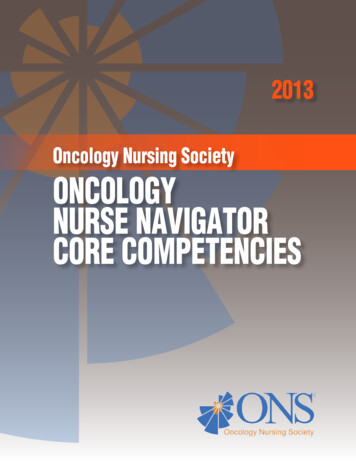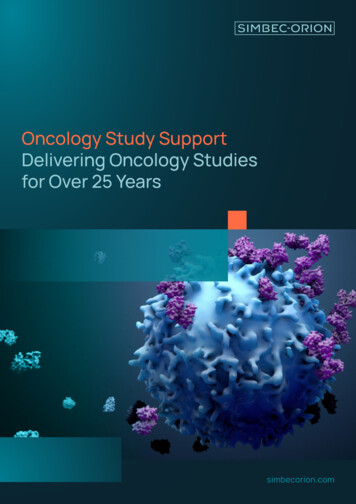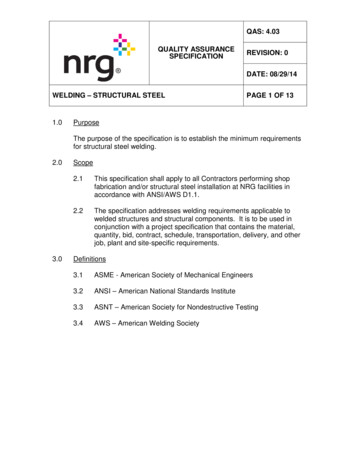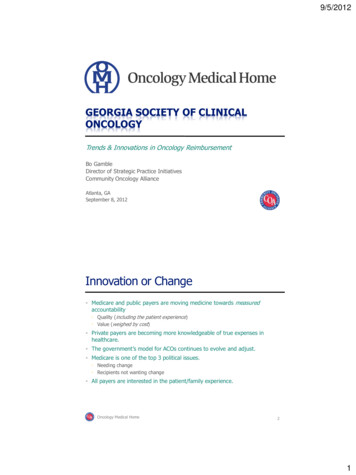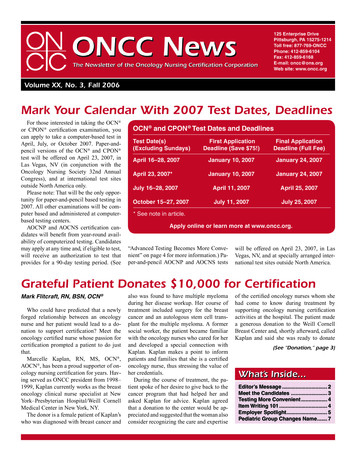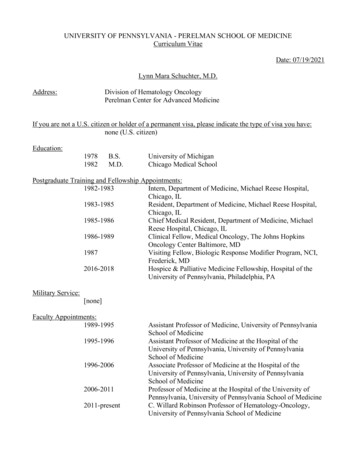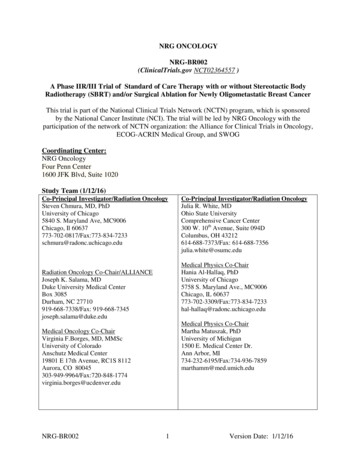
Transcription
NRG ONCOLOGYNRG-BR002(ClinicalTrials.gov NCT02364557 )A Phase IIR/III Trial of Standard of Care Therapy with or without Stereotactic BodyRadiotherapy (SBRT) and/or Surgical Ablation for Newly Oligometastatic Breast CancerThis trial is part of the National Clinical Trials Network (NCTN) program, which is sponsoredby the National Cancer Institute (NCI). The trial will be led by NRG Oncology with theparticipation of the network of NCTN organization: the Alliance for Clinical Trials in Oncology,ECOG-ACRIN Medical Group, and SWOGCoordinating Center:NRG OncologyFour Penn Center1600 JFK Blvd, Suite 1020Study Team (1/12/16)Co-Principal Investigator/Radiation OncologySteven Chmura, MD, PhDUniversity of Chicago5840 S. Maryland Ave, MC9006Chicago, Il chicago.eduMedical Physics Co-ChairHania Al-Hallaq, PhDUniversity of Chicago5758 S. Maryland Ave., MC9006Chicago, IL c.uchicago.eduRadiation Oncology Co-Chair/ALLIANCEJoseph K. Salama, MDDuke University Medical CenterBox 3085Durham, NC 27710919-668-7338/Fax: 919-668-7345joseph.salama@duke.eduMedical Physics Co-ChairMartha Matuszak, PhDUniversity of Michigan1500 E. Medical Center Dr.Ann Arbor, eduMedical Oncology Co-ChairVirginia F.Borges, MD, MMScUniversity of ColoradoAnschutz Medical Center19801 E 17th Avenue, RC1S 8112Aurora, CO ucdenver.eduNRG-BR002Co-Principal Investigator/Radiation OncologyJulia R. White, MDOhio State UniversityComprehensive Cancer Center300 W. 10th Avenue, Suite 094DColumbus, OH 43212614-688-7373/Fax: 614-688-7356julia.white@osumc.edu1Version Date: 1/12/16
NRG ONCOLOGYNRG-BR002A Phase IIR/III Trial of Standard of Care Therapy with or without Stereotactic BodyRadiotherapy (SBRT) and/or Surgical Ablation for Newly Oligometastatic Breast CancerStudy Team ContinuedTranslational Research Co-ChairWendy A. Woodward, MD, PhDM.D. Anderson Cancer Center1515 Holcombe Blvd, Box 1202Houston, TX 77005713-563-8481/Fax: 713-563-6940wwoodward@mdanderson.orgQuality Assurance Co-ChairMichael T. Milano, MD, PhDUniversity of Rochester601 Elmwood Ave. Box 647Rochester, NY 14642585-273-4096/Fax: 585-275-1531michael milano@urmc.rochester.eduSurgical Oncology Co-Chair/ALLIANCENora Jaskowiak, MDUniversity of Chicago5841 S. Maryland Ave. MC 4052University of Chicago Medical CenterChicago, IL 60637773-702-2047/Fax: col AdministratorKathryn OkrentNRG Oncology1818 Market Street, Suite 1720Philadelphia, PA 19103215-717-0856okrentk@nrgoncology.orgLead StatisticianKathryn Winter, MSNRG Oncology1818 Market Street, Suite 1720Philadelphia, PA 19103215-574-3198winterk@nrgoncology.orgData ManagersDebora Grant, RN, MSNNRG Oncology1818 Market Street, Suite 1720Philadelphia, PA al Research StatisticianHanna Bandos, PhDDepartment of Biostatistics, GSPHUniversity of PittsburghNRG Oncology201 North Craig St., Suite 350Pittsburgh, PA 15213412-383-2554/Fax: 412-383-1387bandosh@nrgoncology.orgWendy Bergantz, RNNRG Oncology1818 Market Street, Suite 1720Philadelphia, PA 2RT Technical DetailsSusan McNulty, BS, RT (R) (T),CMDNRG Oncology1818 Market Street, Suite 1720Philadelphia, PA 19103215-940-8907smcnulty@acr.org2Version Date: 1/12/16
NRG ONCOLOGYNRG-BR002A Phase IIR/III Trial of Standard of Care Therapy with or without Stereotactic BodyRadiotherapy (SBRT) and/or Surgical Ablation for Newly Oligometastatic Breast CancerParticipating SitesU.S.CanadaApproved International Member SitesAmendment 1ActivationDocument HistoryVersion/Update Date1/12/1612/05/2014Broadcast Date2/22/1612/24/2014This protocol was designed and developed by NRG Oncology. It is intendedto be used only in conjunction with institution-specific IRB approval forstudy entry. No other use or reproduction is authorized by NRG Oncologynor does NRG Oncology assume any responsibility for unauthorized use ofthis protocol.NRG-BR0023Version Date: 1/12/16
NRG ONCOLOGYNRG-BR002A Phase IIR/III Trial of Standard of Care Therapy with or without Stereotactic BodyRadiotherapy (SBRT) and/or Surgical Ablation for Newly Oligometastatic Breast CancerCANCER TRIALS SUPPORT UNIT (CTSU) ADDRESS AND CONTACTINFORMATION (04/16/14)To submit site registration For patient enrollments:Submit study data :documents:CTSU Regulatory OfficePlease refer to Section 5.0 of theNRG Oncology1818 Market Street, Suiteprotocol for instructions on using the 1818 Market Street,1100Oncology Patient EnrollmentSuite1720Philadelphia, PA 19103Network (OPEN) which can bePhiladelphia, PAPhone: 1-866-651-CTSUaccessed at19103Fax: 215-569-0206https://www.ctsu.org/OPEN SYSTEEmail:M/ or https://OPEN.ctsu.org.Submit dataCTSURegulatory@ctsu.coccelectronically via theg.org (for submittingContact the CTSU Help Desk withNRG Oncology/RTOGregulatory documents only)any OPEN-related questions atweb site, www.rtog.orgctsucontact@westat.comDo not submit studydata or forms to CTSUData Operations. Donot copy the CTSU ondata submissions.The most current version of the study protocol and all supporting documents must bedownloaded from the protocol-specific Web page of the CTSU Member Web site located athttps://www.ctsu.org. Access to the CTSU members’ website is managed through the CancerTherapy and Evaluation Program - Identity and Access Management (CTEP-IAM) registrationsystem and requires user log on with CTEP-IAM username and password.For patient eligibility or treatment-related questions: Contact the Study PI of the LeadProtocol Organization”.For non-clinical questions (i.e. unrelated to patient eligibility, treatment, or clinical datasubmission) contact the CTSU Help Desk by phone or e-mail:CTSU General Information Line – 1-888-823-5923, or ctsucontact@westat.com. All calls andcorrespondence will be triaged to the appropriate CTSU representativeFor detailed information on the regulatory and monitoring procedures for CTSU sitesplease review the CTSU Regulatory and Monitoring Procedures policy located on the CTSUmembers’ website https://www.ctsu.org education and resources tab CTSU OperationsInformation CTSU Regulatory and Monitoring PolicyThe CTSU Web site is located at https://www.ctsu.orgNRG-BR0024Version Date: 1/12/16
TABLE OF CONTENTSSCHEMA .71.OBJECTIVES .81.1Primary Objectives.81.2Secondary Objectives.81.3Translational Research Objectives .82.BACKGROUND .92.1NRG-BR002 Rationale And Trial Design .122.2Translational Research .143.PATIENT SELECTION, ELIGIBILITY, AND INELIGIBILTY CRITERIA .163.1Patient Selection Guidelines .163.2Eligibility Criteria .163.3Ineligibility Criteria .174.REQUIREMENTS FOR STUDY ENTRY, TREATMENT, AND FOLLOW-UP .184.1Response/Failure Definitions .214.2Disease Progression And Subsequent Treatment: .225.TREATMENT PLAN/REGIMEN DESCRIPTION.225.1Chemotherapy/Hormonal Therapy/Other Agent-Based Therapy .235.2Radiation Therapy.235.3Surgery .635.4General Concomitant Medication And Supportive Care Guidelines .645.5Duration Of Therapy .666.TREATMENT MODIFICATIONS/MANAGEMENT .667.ADVERSE EVENTS REPORTING REQUIREMENTS .667.1Protocol Agents .667.2Adverse Events And Serious Adverse Events .667.3Expedited Reporting Of Adverse Events .678.REGISTRATION, STUDY ENTRY, AND WITHDRAWAL PROCEDURES .698.1Investigator Registration Requirements .698.2Site Registration Requirements.708.3RT-Specific Pre-Registration Requirements.728.4Patient Enrollment .749.DRUG INFORMATION .75NRG-BR0025Version Date: 1/12/16
10.PATHOLOGY/BIOSPECIMEN .7511.SPECIAL STUDIES (NON-TISSUE) .8212.MODALITY REVIEWS .8212.1 Radiation Therapy Quality Assurance Reviews .8212.2 Surgical Quality Assurance Reviews .8313.DATA AND RECORDS .8313.1 Data Management/Collection .8313.2 Summary of Data Submission .8413.3 Global Reporting/Monitoring .8414.STATISTICAL CONSIDERATIONS.8414.1 Study Design .8414.2 Study Endpoints .8414.3 Primary Objectives Study Design .8514.4 Study Monitoring of Primary Objectives .9014.5 Accrual Considerations .9114.6 Secondary or Exploratory Elements .9214.7 Gender/Ethnicity/Race Distribution.93REFERENCES .95NRG-BR0026Version Date: 1/12/16
NRG ONCOLOGYNRG -BR002A Phase IIR/III Trial of Standard of Care Therapy with or without Stereotactic BodyRadiotherapy (SBRT) and/or Surgical Ablation for Newly Oligometastatic Breast CancerSCHEMA (1/12/16)PATIENT POPULATIONPatients with locally controlled metastatic breast cancer and 2 metastases(at least 1 pathologically confirmed) visualized on CT or PET/CT.STRATIFICATION Number of metastases (1 vs. 1)Hormone receptor status (ER and/or PR positive vs. ER and PR negative)HER2 status (Positive vs. Negative)First-line standard systemic chemotherapy (Yes vs. No)RANDOMIZATIONArm 1 a, bStandard of care systemic therapy Arm 2Standard of care systemictherapyaAblation of all metastases(SBRT or surgery ablation)caStandard of care systemic therapy for metastatic disease will be given as appropriate for the patient’sdisease subtype (ER , HER2 , TNBC) at the discretion of the treating physician.bMetastatic sites present at registration that require palliation in Arm 1 can be addressed by standardpalliative therapy (i.e., radiotherapy), surgery, or interventions such as vertebroplasty, RFA, etc.) (seeSection 5.0).cThe selection of either surgery or radiation for ablation of a given metastasis in Arm 2 is at thediscretion of the treating physician. See Sections 5.2 and 5.3.NRG-BR0027Version Date: 1/12/16
1. OBJECTIVES1.1Primary ObjectivesPhase II-RTo determine whether ablation (through SBRT and/or surgical resection of all knownmetastases) in oligometastatic breast cancer patients provides a sufficient signal forimproved progression-free survival (PFS) to warrant full accrual to the Phase III portionof the trialPhase IIITo determine whether ablation (through SBRT and/or surgical resection of all knownmetastases) in oligometastatic breast cancer patients significantly improves overallsurvival (OS)1.2Secondary Objectives To evaluate treated metastasis control according to tumor receptor status (ER, PR,HER-2), use of chemotherapy, surgery vs. ablative therapy, and solitarymetastasis vs. 2 metastasis (may expand to 2 to 4 following completion of aPhase I trial) To evaluate whether the addition of ablative metastasis directed therapysignificantly reduces the number of distant recurrences (new metastases) inpatients who progress according to tumor receptor status (ER, PR, HER-2); use ofchemotherapy, and solitary metastasis vs. 2 metastases (may expand to 2 to 4following completion of the Phase I NRG-BR001 trial). To evaluate adverse events in patients who receive ablative metastasis-directedtherapy to all known metastases in addition to standard medical therapy comparedwith those treated with standard medical therapy alone. To explore the most appropriate and clinically relevant technological parametersto ensure quality and effectiveness throughout the radiation therapy processes,including imaging, simulation, target and critical structure definition, treatmentplanning, image guidance, and delivery.1.3Translational Research Objectives1.3.1 Primary ObjectiveTo determine whether 5 CTCs (per 7.5ml of blood) is an independent prognostic(outcome) marker for improved PFS and OS in oligometastatic breast cancer1.3.2 Secondary Objectives To determine whether 5 CTCs (per 7.5ml of blood) is an independent predictive(response to therapy) marker for improved PFS and OS in oligometastatic breastcancer To determine whether eliminating CTCs (0/7.5ml of blood in patients with at least2 CTCs at registration) is both a prognostic and predictive marker for improvedPFS and OS. To evaluate the prognostic and predictive properties of CTC count as a continuousmeasure of PFS and OS To store material for retrospective analysis of ctDNA.NRG-BR0028Version Date: 1/12/16
To store material for retrospective analysis of circulating microRNA.2. BACKGROUNDSeveral clinically-based hypotheses have attempted to explain the metastatic spread of breastcancer. Halsted (1907) argued for an orderly spread from primary tumor to regional lymphnodes to metastases. Rubin and Green were the first to suggest, in 1968, (Rubin SolitaryMetastases 1968) the notion of “solitary metastases” and that such metastatic tumors couldbe treated with curative intent. A systemic hypothesis articulated most clearly by Fisher(1980) suggested that widespread dissemination of disease occurred before clinical detection.Based on the observation that not all breast cancer may be widely metastatic at initialpresentation, Hellman advanced our understanding of the natural history of metastasis byproposing a spectrum hypothesis of metastasis. Within this model, some breast cancersremain locoregionally confined, others metastatic at presentation, and some progress fromlocoregional confinement to metastatic (Hellman, 1994). Soon thereafter, Hellman andWeichselbaum described the clinically relevant oligometastatic state in patients with limitednumber of metastases and where long-term disease control may be achievable withmetastasis-directed therapy (Hellman 1995).The current standard of care (SOC) for metastatic breast cancer (MBC) patients is to deliverpalliative chemotherapy, biologic and/or hormonal therapy when appropriate, with radiationand/or surgery reserved for the management of symptomatic or non-responsive metastases. Inthis paradigm, a very small number of MBC patients are alive long-term. A population-basedanalysis by Greenberg et al. (1996) reported the outcomes of over 1,500 women with MBCtreated at M.D. Anderson Cancer Center with doxorubicin and alkylating agent-basedchemotherapy; 1.6% remained free of relapse at 15 years. These data, coupled with theaccepted curative role that adjuvant chemotherapy plays in the non-metastatic settingsuggests that systemic therapies are helpful in addressing micrometastatic spread of breastcancer. However, single or poly-agent chemotherapy is unlikely to be curative in patientswith gross (image detected) metastases.For selected patients with limited metastatic disease, metastasis-directed therapy, eithersurgical resection or ablative radiotherapy (in addition to standard systemic therapies) to lung(Simpson 1997, Rusthoven 2009, Fumagalli 2012) liver (Fong 1997, Rusthoven 2009,Dewas 2012, Vlastos 2004, Fumagalli 2012), CNS (Wronski 1995, Kocher 2011, Maclean2013), adrenal (Tanvetyanon 2008, Torok 2011), and multiple organs (Salama 2012, Milano2012) has been shown to result in long-term disease control numerically superior to that seenwhen systemic therapy is administered alone. Specifically in breast cancer patients, ablativemetastasis-directed therapies have been shown to result in promising PFS and OS (Abbott2012, Fridel 2002, Staren 1992, Pockaj 2010, McDonald 1994, Milano 2009). While thesereported series have been primarily retrospective, taken together they identify long-termsurvival from metastasis-directed therapy in patients with limited breast cancer metastases.The benefits these patients derive may come from delaying progression in known metastases,as well as preventing known metastases from seeding new metastases. Furthermore, ablativeradiation may have an abscopal effect, improving outcomes by inhibiting progression ofmicrometastatic foci (Demaria 2004, Formenti 2008, Stamell 2012).We hypothesize that ablative metastasis-directed therapy with either Stereotactic BodyNRG-BR0029Version Date: 1/12/16
Radiotherapy (SBRT) or surgery in combination with standard systemic therapy maymeaningfully impact the natural history of some oligometastatic breast cancers. Indeed, Treeand colleagues observed in a 2013 review that a large number of non-randomized studieshave found a 2-5 year progression-free survival rate approaching 20%, signaling atremendous improvement with the application of SBRT to oligometastatic disease ( Tree2013).In order to provide improved prognostic information for patients with oligo MBC andpotentially to predict those patients likely to respond favorably to aggressive chemotherapyor biologic agents, new biomarkers have been developed. One of the most promisingtechniques relies on detecting the presence of circulating tumor cells (CTCs) in patients withMBC. Data suggest these circulating tumor cells may be close in origin to the tumor stemcells responsible for metastatic disease. Using the FDA-approved and commercially availableCellSearch assay, 5 CTCs (per 7.5ml of blood) prior to first or second line chemotherapypredicts progression-free survival (PFS) and overall survival (OS) (Cristofanilli 2004). Theprognostic value of CTCs in response to chemotherapy appears superior to other widely usedprognostic tools such as metastases location or type of chemotherapy employed.A recently completed Phase III trial (SWOG S0500) altered treatment selection ofchemotherapy based on 5 CTCs (per 7.5ml of blood) detected and levels in the blood.These recently reported results showed those with high levels of CTCs that decreased withtherapy did better than those with high levels of CTCs that persisted after therapy.Unfortunately, changing therapy did not improve outcomes for patients with high CTCs,potentially because the standard next line therapies available do not often have significantclinical benefit for this cohort. It is important to note that the current trial represents a verydifferent population than the SWOG 0500 study. Herein the patients have oligometastaticdisease as opposed to unselected metastatic disease. Further, those who progress on standardtherapy will not be eligible representing a selection for good prognosis oligometastaticdisease in this trial.The challenge for ablative therapy in MBC is to identify those patients for whom thisapproach might be at least beneficial and possibly curative. Pragmatically, it should becurative for patients in whom the visible disease to be treated is truly all of the disease, andwhere the ability of existing circulating disease to seed new sites is minimal, either becausethere are few circulating cells being shed, or because a high volume of cells are circulatingbut they lack the biology to seed. The former is easier to identify using CTCs. One mightexpect that in metastatic patients with few or no CTCs, ablative therapy may provide durableNED status, since new metastases are less likely to form because small volume circulatingdisease that is not seeding may be eradicated by systemic agents more readily than grossdeposits of tumor. For those with high levels of CTCs, we hypothesize that eradication ofCTCs by ablative therapy will indicate that the primary source of CTCs is the known andtreatable metastases, and not occult metastases likely to re-seed after ablative therapy andprevent durable no evidence of disease (NED) status. Of course, failure to ablate the knowndisease would also fail to eradicate CTCs.The proportion of MBC patients who present with 1-2 metastases is high. Prior first-lineMBC trials were reviewed to determine an estimated frequency of patients who would fit theinclusion criteria for this clinical trial. Approximately 50% of the patients from these trialsrepresenting differing ER and HER2 status enrolled with 2 metastases. A current Phase INRG-BR00210Version Date: 1/12/16
trial is assessing the safety of ablating 4 metastases [NRG-BR001]. If this Phase I trialconfirms the safety of 4 metastases as targetable for ablative therapy, then an amendmentto the current protocol would increase the enrolling population to upwards of 75% of firstline MBC patients as potentially eligible. These studies demonstrate that first-line metastaticpatients likely to enroll on clinical trials often present with oligometastatic disease andwould qualify for enrollment in this clinical trial.SBRT is being increasingly used as a technique to treat patients with limited MBC. A recentinternational survey of radiation oncologists (Lewis 2013) found that 61% of respondentswere using SBRT to treat patients with limited metastatic disease. Furthermore, of those notcurrently offering this treatment, more than half were planning to start offering SBRT forlimited metastases in the next 3 years. Therefore, at the time of activation of this study, 75%of practicing radiation oncologists will be offering this treatment to patients with limitedmetastatic disease. While there is increasing evidence that administration of SBRT foroligometastatic disease is measurably beneficial and its use is becoming more common, theinitiation of randomized trials to ultimately prove clinical benefit will be increasinglydifficult due to SBRT becoming the de facto standard of care (Tree 2013). Therefore, thisproposed randomized clinical trial is profoundly important not only due to the anticipatedtreatment outcomes, but also because of the imperative to ensure safety and benefit before anunproven consensus of approach becomes more widely accepted.NRG-BR00211Version Date: 1/12/16
Table 2-1. Frequency of patients enrolled on first-line metastatic breast cancer trials withlimited number of metastatic sites who appear potentially eligible for ablative therapy.Author/StudyIIPhasenER/PR HER2 (%)- 2 met 4 MetsitesSites(%)(%)911. Gem Paclitaxel2. Paclitaxel9.898.452-1 Sunitinib Docetaxel2. Docetaxel8.68.357Albain 200859932IIIBergh 201259372Pos.PFS(Mo.)ArmsTawfik2013II3077Neg.50-1. 49.3-1. Trastuz Docetaxel2. T-DM19.214.2-1. Docetaxel Trastuz2. Docet Tras BEV13.716.5-1. Doxorubicin2. Paclitaxel3. Doxorubicin ELIIIE11937395145Pos-5049*Time To Failure2.1NRG-BR002 Rationale and Trial DesignWe propose to evaluate an alternative treatment paradigm for this subset ofoligometastatic MBC patients: elective ablation of all metastases after systemic therapywith a Phase II/III trial design.The randomized Phase II portion will compare the standard of care, systemic therapy andpalliative surgery/radiation therapy (non-SBRT) only to areas of pain or potential andsignificant clinical risk (Arm 1), with ablation of all visible metastases in addition tostandard systemic therapy (Arm 2). If a PFS signal is observed, a Phase III trial would bewarranted to determine whether OS at five years is significantly improved. As asecondary endpoint, we will evaluate whether 1) the absence or low number of CTCs(using the FDA approved Cellsearch assay at registration) may be predictive of thoselikely to obtain durable PFS, 2) eradication of CTCs from registration to follow-upsufficient to complete SBRT (4 weeks after SBRT) on Arm 2 and initiate SOC therapy onArm 1 (3 months) is predictive of durable PFS, and 3) whether this successful eradicationcan be of prognostic value for PFS and OS. We predict those with few or no CTCs areideal candidates for SBRT and will have longer PFS than those with 5 CTCs (per 7.5mlof blood), and that eradication of CTCs with SBRT will be possible and will identifyNRG-BR00212Version Date: 1/12/16
patients in whom CTCs originated from ablated metastases as opposed to those withCTCs from occult disease or CTCs from ablated metastases that seeded prior to ablationof metastases. Further, we hypothesize that PFS will be longer in those with zero or lowlevels of CTCs ( 5/7.5ml of blood) treated with ablative therapy than with supportivecare, and that those with eradication of CTCs in either arm will have longer PFS thanthose with persistent CTCs at the follow-up collection. If the former were true, CTCscould be used to identify patients for ablative therapy and if the latter were true, changein CTCs could be used to identify those who should receive additional adjuvant therapiesafter ablative therapy.This design would directly test the hypothesis that some metastases may be the source ofnew disease spread, as suggested by recent translational studies (Karnoub 2007,Valastyan2009). For example, patients for whom there are minimal shed CTCs at the time ofpresentation or in cases where CTCs shed from ablative-treatable lesions lack the biologyto seed new metastases effectively, ablative therapy may establish durable PFS. If lowlevels of CTCs at registration correlate with PFS after ablative therapy, this would be ameaningful adjunct to clinical findings in order to select patients for this approach.Further outcome can be compared between those on each arm with low levels of CTCs ( 5/7.5ml of blood) for hypothesis generation regarding the optimal therapy in this setting.If ablative therapy in the setting of eradication of CTCs correlates with PFS, this could beincorporated in future studies to determine the timing and utility of systemicchemotherapy most beneficial in these cases. These data would truly help shape practicein the metastatic setting, where limited metastatic disease is amenable to ablative therapy.The rate of eradication of high levels of CTCs ( 5/7.5ml of blood) can be compared inthe ablative and SOC arms to generate hypotheses regarding the preferred approach inthis setting as well.This would be the first randomized trial to answer whether ablation through surgery orSBRT can alter the progression of MBC treated with standard systemic therapy.Furthermore, this would be the first National Clinical Trials Network randomized studyto evaluate prospectively the multimodal use of ablative metastasis-directed therapy(either surgery and/or radiotherapy) integrated into the metastatic treatment. Whileablative radiotherapy is currently being used either in small, single institution trials or offprotocol, no data exist in a randomized setting to demonstrate its efficacy or justify theadoption. The results of this trial paired with ongoing and recently completed studieswould significantly enhance our knowledge about the impact of these therapies. Aseamless randomized Phase II/III design is critical to first observe a signal in PFSindicating the need for a Phase III investigation.Whether through demonstrating either an im
NRG Oncology 1818 Market Street, Suite 1720 Philadelphia, PA 19103 215-717-0856 okrentk@nrgoncology.org Data Managers Debora Grant, RN, MSN NRG Oncology 1818 Market Street, Suite 1720 Philadelphia, PA 19103 215-574-3206 grantd@nrgoncology.org Wendy Bergantz, RN NRG Oncology 1818 Market Street, Suite 1720 Philadelphia, PA 19103 215-574-3230
